Polycarbonate
If the requirements for the plastic product to be used are particularly high, thermoplastics are not far away.
Polycarbonate is generally used where other plastics are too fragile, too scratch-sensitive, or not dimensionally stable enough. However, the specific properties of polycarbonate are demanding and place high requirements on the screening technology used.
It is supplied in primary form as pellets or granules to the plastics processing industry, which then processes it into end products. To ensure the quality of the end products, the raw material must also be flawless.
Products made of polycarbonate are impact-resistant and particularly shatterproof. In combination with other materials, polycarbonate is so stable that it is used in the manufacture of bulletproof glass. Or for roof structures of stadiums and train stations. We also encounter polycarbonate products on a smaller scale: in eyeglass lenses, for example, because it is shatterproof and at the same time much lighter than mineral glass.
Before polycarbonate can be processed into end products, it must meet the highest quality standards and be in “flawless” form. For this purpose, adhering dust particles, agglomerates and excess lengths are screened out in the course of the manufacturing process using a special screening method in order to achieve the optimum particle size and quality for processing.
However, the properties of plastics in primary form complicate the screening task.
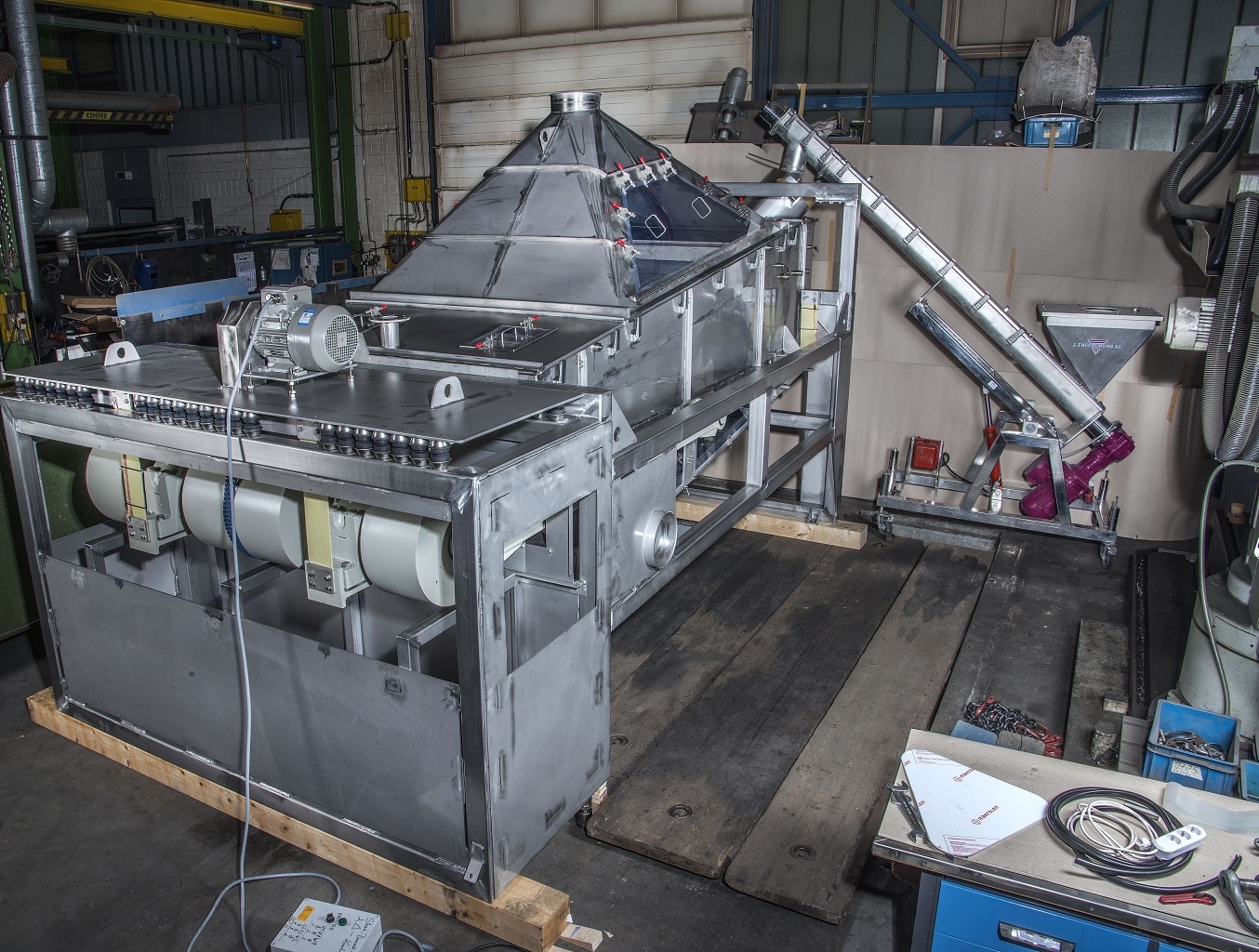
Screening of polycarbonate with the JEL Freischwinger:
the vibrating screening machine combines separation efficiency and screening that is particularly gentle on the product. After tests with the original product, the Engelsmann designers were sure that the machine met the customer’s requirements as desired.
Project Challenges
1. Separation of coarse and fine grains
For a high-quality end product, a homogeneous grain size of the starting product is crucial. On the one hand, however, the granular raw material contains too large grain sizes (strands, doubles, triples, fibers). These should be screened out with a separation efficiency of at least 98.5%. On the other hand, fine dust particles also adhere to the granules and must also be removed from the product in order to achieve a homogeneous grain size of the screenings at the end of the screening process.
2. Connection to production and filling
Another challenge was to fit the screening machine into the upstream production process. An upstream strand pelletizer, which breaks up the plastic strands formed in the extruder into small pellet-shaped particles by cutting them into smaller pieces, resulted in confined space conditions at the installation site. In the design of the screening machine, the individual conditions were taken into account in such a way that no costly conversion work was necessary at the installation site.
Customized screening machine
Drying during the sieving process optimizes product sieving capacity
To meet the customer’s requirements in terms of screening quality and throughput, a JEL Freischwinger in double-deck design was used, which was adapted to the screening task with additional functions.
The screening machine with a free-swinging screen housing was specially designed for screening dry and free-flowing bulk materials. Due to its high throughput capacity of up to 250 t/h, the particularly gentle screening process and the high separation efficiency of up to 99%, the JEL free-swinging screen was the suitable screening machine.
The polycarbonate granules fed from the strand granulator are screened from fine to coarse via two screen decks arranged one above the other. Via a product return floor, the granules are fed to the lower screen deck and screened again, so that the lower screen deck acts as a control screen to ensure the required degree of screening.
Matched to the required throughput capacity of 20 t/h as well as the desired granule specification (2.5 x 3.0 mm), the upper screen deck is equipped with six screen layers made of perforated plate with a diameter of 4.5 mm per hole and the lower screen deck with six screen layers and hole diameter of 6 mm. Thus, the vibrating screen has a total net screening area of 10.5 square meters.
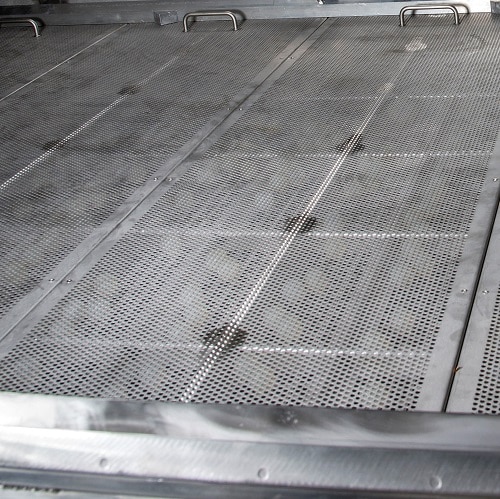
View of the upper screen deck. Visible below: the bale cleaning system
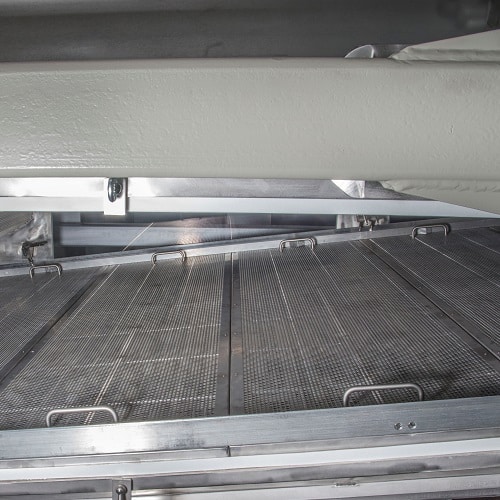
Control screening takes place on the lower screen deck. Each sieve deck is composed of individual sieve insert segments.
In order to achieve optimum screening capability of the product surface-moistened by the strand granulator, the polycarbonate granules are continuously dried and cooled at the same time during the screening process. In order to map this customized process sequence, design adjustments were made to the basic model of the JEL Freischwinger unit, thus tailoring the screening plant to the task and the plant environment.
1. Air circulation
In addition to the six standard perforated plate inserts, two additional inserts have been installed which ensure continuous air circulation during the screening process via an air inlet nozzle mounted above the screening trough. This dries the product and at the same time cools it down from 60°C to 40°C.
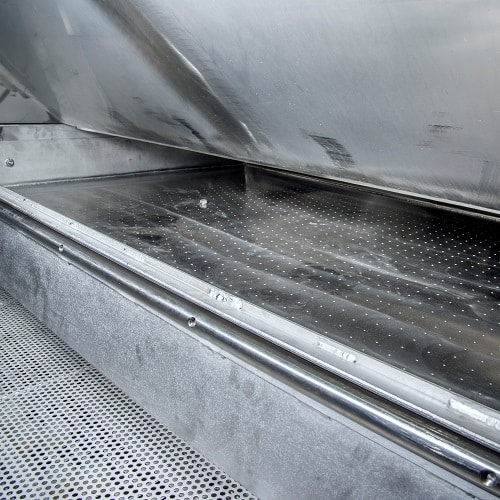
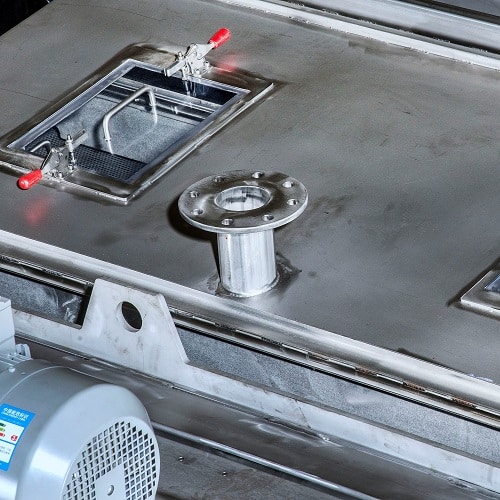
2. Dedusting
The air circulation also has the effect of removing dust from the polycarbonate granules in the counter-air flow. Dust particles adhering to the product are carried along into a downstream filter system to which the screening machine is suitably docked.
3. Dehumidification
The condensate produced by the accompanying drying process is continuously discharged with the air flow via a discharge funnel on the cover of the machine.
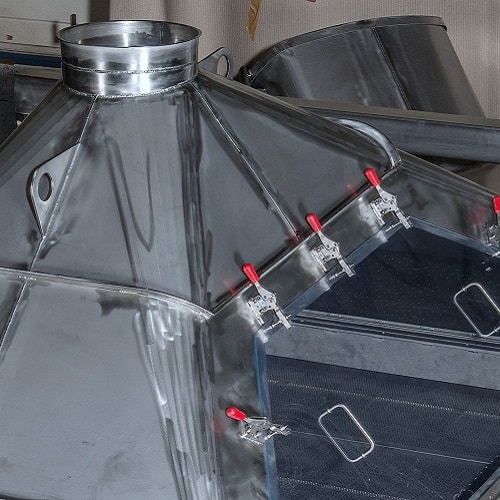
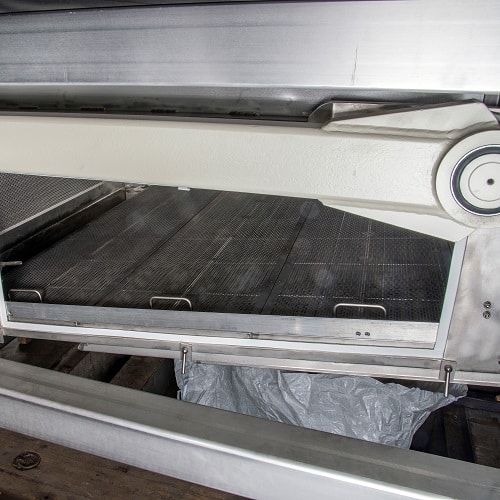
4. Transfer of the good to the filling department
The accepts, which must not exceed 2.5 x 3.0 mm in diameter and length, fall out of the machine via the accepts outlet at the lower sifting trough and are fed to the downstream filling process.
5. Discharge of the coarse material
The coarse material that cannot be used for further processing leaves the machine via the coarse material outlet provided for this purpose.
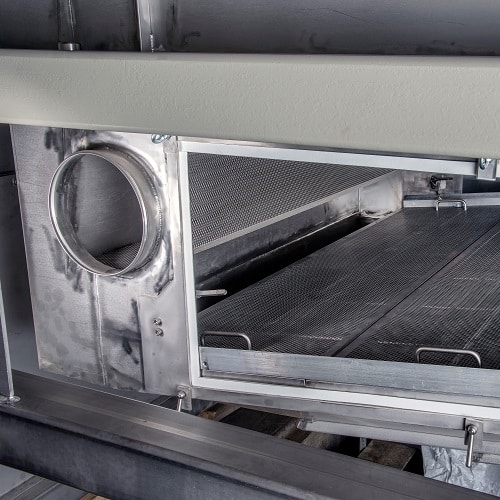
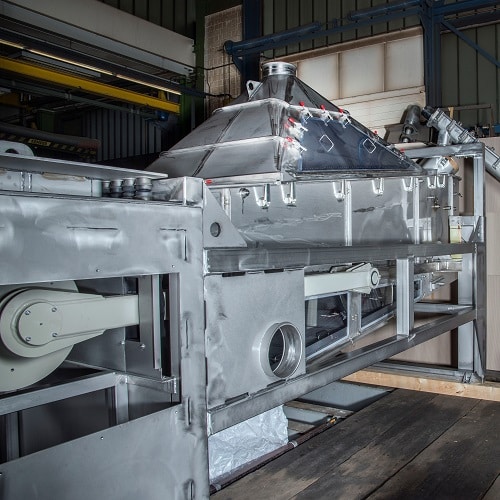
6. Adaptation to the conditions on site
The inlet and outlet nozzles have been arranged according to local conditions. The inlet for product feeding is now located on the end-bearing side, and not on the drive side as in the standard model. The shape, contour and angle of inclination of the inlet spout have also been adapted to the outlet spout of the strand pelletizer.
7. Quality materials
The screening machine including all parts in contact with the product, except the drive unit, is made of high-quality stainless steel (V4A 1.4571). In addition, the use of seals and the use of other metals was dispensed with in the interior of the sieve trough. The installed screen cleaning system is equipped with silicone balls to avoid contamination of the granular product by material abrasion.
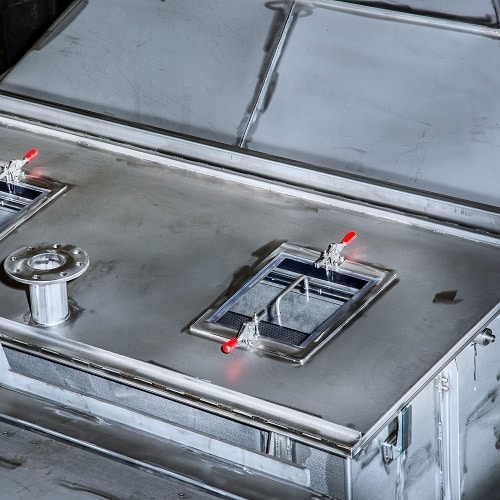
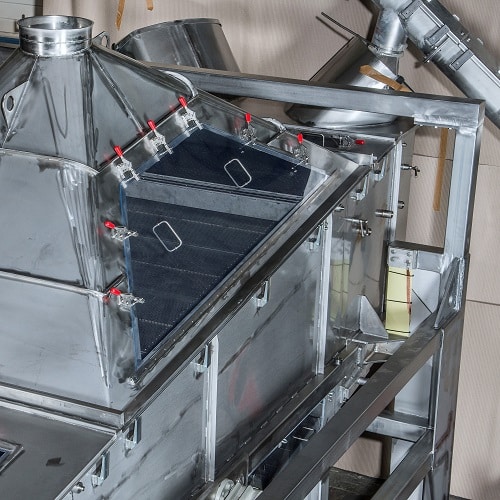
8. Everything in view
For visual monitoring of the screening process, the machine is equipped with generous Makrolon panes: in the lid as well as laterally at the level of the lower screen deck. Thanks to the shatterproof protective panes, the granulate distribution or the product flow within the screening machine can be checked visually.
Economical machine use due to modular design and flywheel drive:
Easy cleaning – energy-saving operation
For minimum downtimes and the targeted machine availability on 360 days p.a. in three-shift operation, it is important that the screening machine can be cleaned with little time expenditure. To ensure that the machine’s performance is maintained over the long term, 5 working days p.a. are scheduled for regular maintenance intervals.
Cleaning
- Thanks to the modular design and quick-change design, the sieve inserts, which are locked in place by pressure bars, can be changed in just a few steps after removing the cover.
- The free access to the sieve inserts and their easy disassembly allow cleaning of all product-contacting parts inside the sieve in a short time without leaving any residues.
- In addition, the internal parts can be easily accessed and replaced for repair and maintenance.
- The quick-release clamps seal the sieve trough dust-tight with the lid parts and prevent dust particles from escaping during the sieving process.
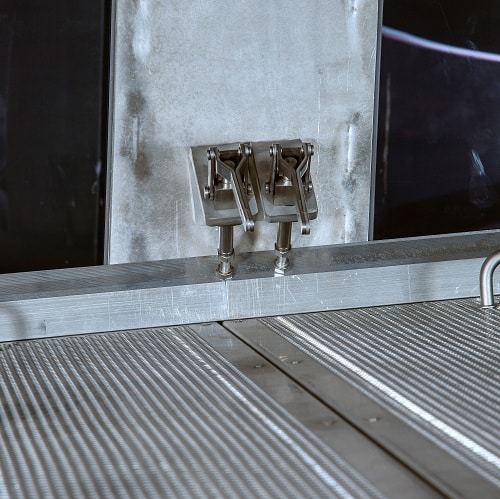
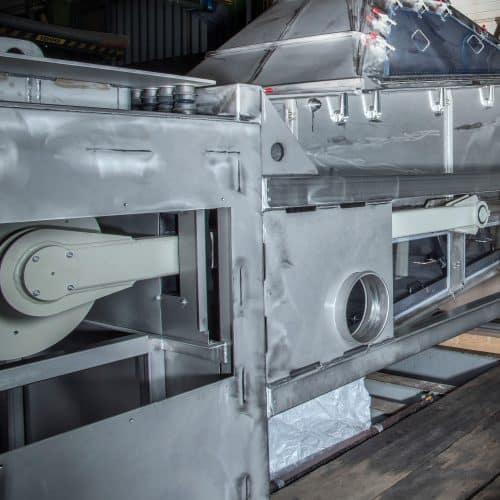
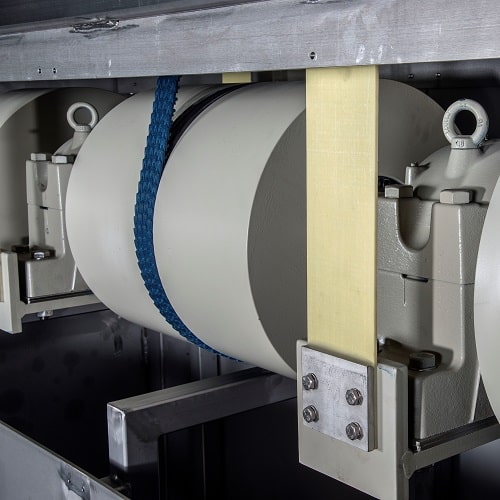
Energy saving operation
For energy-saving operation, the specially designed JEL Freischwinger is equipped with a specially developed flywheel drive.
- The flywheel drive is powered by an electric motor and is connected by means of V-belts to push rods that transmit the drive energy to a flywheel mass.
- The flywheel mass is exactly matched to the mass of the sieve trough. The drive train, i.e. shaft and flywheel, weigh approximately as much as the trough including the screen product.
- The electric motor is particularly energy-efficient: It drives the mass for approx. 15 seconds with full rated current and then keeps it in motion with only 10-20% of the rated current. In the process, the electrical energy is converted into rotational energy, stored in the flywheels and gradually released.
- The machine requires little energy (7.5 kW at 20 t/h throughput) thanks to the drive based on mass balancing.
- In contrast to screening machines with oil-lubricated motor gearboxes, the flywheel drive is subject to only minor wear. This results in low material usage and maintenance requirements.
- Another advantage of the flywheel drive, in view of the machine size and compared to common screening machine makes, is the low-noise operation with less than 79 dB.
The screening machine, designed in accordance with the authenticated inspection body in China (NEPSI), was able to be shipped after a three-month development and production period, where it was assembled and commissioned on site by two Engelsmann service technicians.

